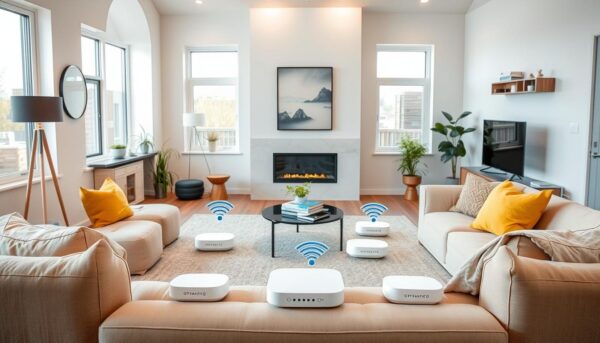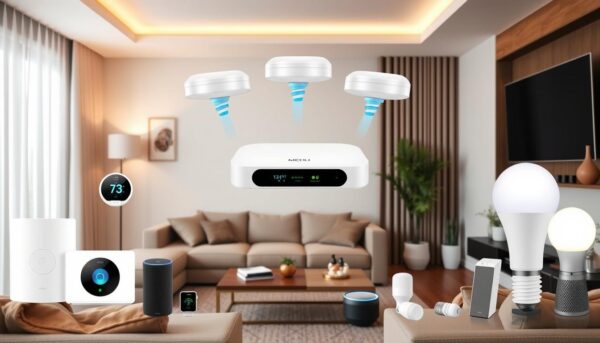Is your home ready for the smart revolution? The Internet of Things (IoT) is changing our homes. Choosing the right network devices is key.
A strong Smart Home Network is vital. It makes sure all your devices work together smoothly.
So, what makes a network “smart”? It’s not just about Wi-Fi. It’s about creating a seamless system where devices talk to each other easily. This includes security cameras and smart thermostats.
The IoT is making our homes smarter and more responsive. With the right setup, you can control lights, check security, and adjust the climate from your phone. But you need a network that can handle it all.
Let’s look at the key parts for a smart home. We’ll help you pick the best devices for a network that’s truly brilliant.
Key Takeaways
- A robust network is essential for optimal smart home performance
- IoT devices are transforming homes into intelligent environments
- The right network setup ensures seamless communication between devices
- Smart home networks require careful planning and device selection
- A well-designed network enhances convenience and home automation
Essential Smart Home Network Components
Building a smart home begins with the right network parts. These devices are the heart of your connected home, making it easy to control and communicate. Let’s look at the key parts of a strong smart home network.
Mesh Wi-Fi Systems
Mesh Wi-Fi systems are a big deal for smart homes. They cover your whole home, getting rid of weak spots and keeping your devices connected. With systems like Eero 6 and TP-Link Deco, you get smooth Wi-Fi everywhere.

Smart Home Hubs and Controllers
Smart home hubs are the center of your automation world. They let you control all your devices from one spot. With voice control systems like Amazon Alexa or Google Assistant, you can use your voice to control things, making it easier to use your devices.
Network Security Gateways
Keeping your smart home safe from hackers is key. Network security gateways protect your devices and data. They have features like encryption and updates to keep your network safe.
| Component | Function | Benefit |
|---|---|---|
| Mesh Wi-Fi | Wide coverage | Eliminates dead spots |
| Smart Home Hub | Device management | Centralized control |
| Security Gateway | Network protection | Cyber threat prevention |
By using these parts, you make your smart home safe, efficient, and easy to use. Remember, a good router is key since many devices use a lot of bandwidth. With the right setup, you’ll enjoy the benefits of home automation.
Best Mesh Wi-Fi Systems for Connected Homes
Choosing the right mesh Wi-Fi system can change how you enjoy your smart home. These systems make it easier to access your home remotely. They also help manage energy and keep your smart lights working smoothly.
Asus ZenWiFi AX (XT8) for Premium Performance
The Asus ZenWiFi AX (XT8) is known for its strong coverage and performance. It covers homes up to 5,500 square feet, perfect for big spaces. It costs $249.99, which is $80 less than its original price.
This system is great at handling many smart devices. It works well with energy management controllers and smart lighting hubs.

Eero 6+ for Budget-Conscious Users
The Eero 6+ is a good choice if you want performance without spending too much. It covers homes up to 4,500 square feet and costs $139.99. It’s good at managing remote access and supports many smart home devices without being expensive.
TP-Link Deco BE63 for Future-Proof Connectivity
The TP-Link Deco BE63 is great for those who want to be ready for the future. It’s priced at $399.99, which is $150 less than its original cost. This Wi-Fi 7 system has the latest technology, making sure your network is ready for new smart home features.
It’s perfect for homes with lots of smart devices and streaming needs. It handles high-bandwidth activities well.
| Mesh System | Coverage | Price | Key Feature |
|---|---|---|---|
| Asus ZenWiFi AX (XT8) | 5,500 sq ft | $249.99 | Premium performance |
| Eero 6+ | 4,500 sq ft | $139.99 | Budget-friendly |
| TP-Link Deco BE63 | Not specified | $399.99 | Wi-Fi 7 support |
Each system has its own benefits for your smart home. Whether you need coverage, affordability, or future-proofing, there’s a mesh Wi-Fi system for you. It will make your smart home experience better.
Smart Home Network Security and Management
Keeping your smart home network safe is key in today’s world of the Internet of Things (IoT). With 80% of IoT devices at risk, it’s vital to act fast to protect your home security. Let’s look at important steps to safeguard your connected home.
First, make sure your Wi-Fi router uses the latest security. Newer routers have WPA3, a big step up from WPA2. This helps block password cracking and keeps your network safe from unauthorized access.
Segmenting your network is also crucial. Set up different networks for IoT devices and personal data devices. This limits attacks and keeps your important info safe.
| Device Type | Recommended Network | Security Level |
|---|---|---|
| Smart Lights, Thermostats | IoT Network | Basic |
| Smartphones, Computers | Personal Network | High |
| Security Cameras | Isolated Network | Advanced |
Always update your smart devices’ firmware. Many IoT devices need manual updates. Outdated firmware leaves your devices vulnerable to attacks.
Use strong, unique passwords for all devices and accounts. A password manager can help create and store complex passwords. This stops a single breach from affecting your whole smart home.
Turn on multi-factor authentication (MFA) on devices like Amazon Echo, Google Nest, and Ring. MFA makes it harder for unauthorized access.
For safe remote access, use a secure VPN connection. This encrypts your data and hides your IP address, protecting your network from intruders.
“Your fridge and your laptop should not be on the same network.” – FBI Warning, 2019
By following these tips, you’ll build a strong security system for your smart home. This ensures peace of mind in our connected world.
Advanced Home Automation Integration
Home automation has changed how we live. Smart speakers and connected devices bring control and convenience to our homes.
Voice Control Systems
Voice control is key in smart homes. Amazon Alexa and Google Assistant lead, working with many devices. They understand and do what you ask, like changing the temperature or lights.
Smart Home Protocols and Standards
Communication protocols are the heart of home automation. Wi-Fi is used for fast data, while Bluetooth is for short distances. Zigbee and Z-Wave manage many devices without interference. The new Matter protocol aims to make all devices work together better.
Device Compatibility Requirements
When setting up your smart home, device compatibility is important. Most devices work with Google Home, Amazon Alexa, or Apple HomeKit. Look for the “Works with” label for easy integration. Also, 55% of people worry about security, so choose devices with strong encryption and updates.
- Choose devices that support your preferred voice assistant
- Look for products compatible with open standards like Matter or Thread
- Consider power requirements and range limitations of different protocols
Understanding these points helps create a smart home that meets your needs. Smart home tech keeps getting better, promising more efficient living spaces.
Conclusion
Building a smart home network is an exciting journey into the future of living. You’ve learned about the essential components needed to create a robust foundation for your connected devices. From mesh Wi-Fi systems to smart home hubs, these technologies work together to bring the Internet of Things (IoT) to life in your home.
The market for smart home devices is booming, projected to reach $174 billion by 2025. With 70% of U.S. households expected to have at least one smart home device by then, it’s clear this technology is here to stay. The benefits are tangible – smart thermostats can save you 10-15% annually on heating and cooling bills, while smart lighting systems can cut energy consumption by up to 40%.
While the initial investment in a smart home network can be significant – up to $15,000 for a fully automated average home – the long-term savings and convenience are worth considering. Users report saving an average of 15 hours per month thanks to automated tasks. As you embark on your smart home journey, remember to prioritize security and compatibility to ensure a seamless, safe experience with your connected devices.